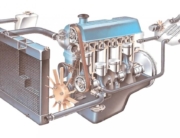The Farm loan technique, America’s the very least regarded government-sponsored organization, has actually an exceedingly sophisticated and progressively useless organizational construction. I blogged a white document for ABA in August that explains the reason this framework should be made simple and just how which can be accomplished.
The FCS dates to 1916, whenever meeting developed the Federal land-bank technique, which contained 12 local national terrain Loan providers (FLBs) to deliver houses loan to farmers and ranchers. FLB finance comprise originated by nearby national terrain Banking institutions Associations (FLBAs), which have been financing cooperatives purchased by their particular borrowers.
The ranch financing work of 1933 licensed the creation of manufacturing credit score rating relationships, or PCAs, to make short-term lending to growers and ranchers, as well as twelve territorial collaborative finance companies and a Central Bank for Cooperatives to give to farming and outlying electric cooperatives. The given regions when it comes to PCAs commonly coincided with FLBA regions.
The FLBA/PCA overlap concluded in the creation of regional Agricultural financing groups (ACAs) that provided both houses and non-real assets debt to farm owners and ranchers. ACAs subsequently did start to format on their own as “parent ACAs, each with a PCA subsidiary company and even a government area loans connection (FLCA) that not only encountered the loaning forces of an FLBA, but will after that keep carefully the real property finance it began, consequently maintaining for each ACA the real-estate income tax exemption the FCS has long treasured.
The 1987 bailout associated with FCS, triggered by the 1980s’ ag problem, led to appreciable integration with the FCS—the number of FCS entities shrank from 845 to the end of 1984 to 196 on July 1, 1999. The cooperative banking companies ultimately consolidated into CoBank, where you have the exclusive power around the FCS to bring to cooperatively-owned farming companies and non-urban utilities.
Right, the FCS has just four regional financial institutions, like CoBank, and 69 organizations. This road includes the territories served because four finance companies, although this chart reveals the relationship regions.
The FCS finance companies, apart from CoBank, function solely as funding intermediaries relating to the FCS associations while the government grazing debt Banking companies financial support group, which lifts resources by selling inside the capital industry reports and securities referred to as the Systemwide financial obligation investments.
Due to the fact www.yourloansllc.com/no-credit-check-loans-online dominant lender associated with interactions it consists of loaned to, each FCS financial institution supplies some monetary lapse of these associations. That supervision allegedly complements the regulatory lapse and routine safety-and-soundness examinations done by the FCS’s regulator, the Farm loan Administration.
The remarkable version within the proportions of the areas was used by the FCS groups parallels the enormous asset-size differential among them. As of March 31, 2019, the organizations varied from absolute resources of $29.88 billion (grazing financing Companies of The usa, offering four reports) and $23.71 billion (Farm Credit Mid-America, offering all or portions of four shows) to Delta ACA, which assists just five counties in southeast Arkansas, with $49 million of possessions.
Additional relief among remaining four FCS banks is unlikely from a little-known element of FCS loans granted from budget company each added lender merger would moreover deteriorate the joint-and-several accountability the residual banking institutions could have for the Systemwide loans investments released through the investment group. Which, if an FCS financial institution cannot spend the attention expected regarding the financing it offers took from your money firm or repay the pilfered investments as soon as because, next the other three banking institutions tend to be mutually liable for that loans.
The next FCS bank merger would further weaken the joint-and-severally-liable feature now backing FCS debt by reducing to two the number of other banks liable for a troubled bank’s obligations if that bank could not meet its debt obligations in a timely manner. Each continuing to be banks would need to shoulder a more substantial part of the defaulting bank’s credit, thus increasing the odds that the other banks would default. A lot of curiously, the joint-and-several responsibility feature backstopping credit issued by financial support business will not run within the FCS interactions.
Being the FCS associations continue to combine and the quantity of creditors has shrunk to an irreducible numbers, the time period has come to authorize each relationship to acquire straight from the funds provider, which often would think the relationship supervision operates at this point sang through the four banks. That is, the functions of three belonging to the creditors just about CoBank would simply be suspected with the investment partnership in addition to the loan providers liquidated. The money financing in each lender would then get transferred to the connections that fit to that financial institution, thereby conditioning the capital among those organizations.
Most importantly of all, the joint-and-several commitment these days dwelling with all the four banking companies would change to your bigger few FCS relationships as they started lending straight from the investment enterprise. That shift would significantly bolster the joint-and-several liability function of FCS financial obligation, which would decrease the taxpayer threat presented by FCS, a threat that turned an actuality in 1987. Curiously, on at any rate three instances, past FCA table chairman, the later Dallas Tonsager implored the FCS to review their existing design and also recommends just how the FCS must restructured.
Simplifying your home or business belonging to the FCS would enhance their running capabilities, which most probably would profit its member/borrowers, while fortifying the FCA safety-and-soundness regulations of this FCS.
One particular section of FCS restructuring will be go CoBank’s at this time unique credit regulators to all or any FCS organizations. Correct, more FCS organizations cannot give to non-urban cooperatives, except with CoBank’s permission or by getting a participation in a home loan to a cooperative started by CoBank.
Lastly, empowering FCS groups to need straight from the Funding company while moving additional FCS financial works around the budget company in addition to the FCA would improve the functioning productivity belonging to the FCS while decreasing the considerable insolvency hazard the FCS right now presents to taxpayers.






